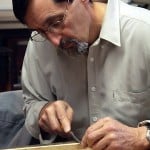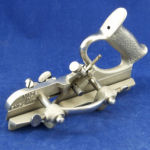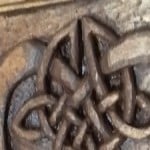Handplane Adventure
Welcome! / Forums / General Woodworking Discussions / Handplane Adventure
- This topic has 31 replies, 16 voices, and was last updated 11 years, 6 months ago by
Anonymous.
-
AuthorPosts
-
 28 December 2012 at 3:46 am #5666
28 December 2012 at 3:46 am #5666About two years ago I bought a new Stanley Bailey #4 at Lowe’s on clearance. I played with it a bit but it never worked like I wanted it to, so it started collecting dust.
I have been woodworking for over 40 years but never used hand planes very much. I am currently making a table top for a neighbor, from 2 x 6 rough Cypress, finished size is 30″ x 60″. I am milled the boards down to 1-5/8 x 5″, gluing two pieces together, so that I have 3 glued up sections 10″ wide. Then I take each of those sections and run them through my 13″ planer again to take it down to 1-1/2 thick. I planned this out ahead of time, knowing that I was going to have to deal with the 30″ wide piece and either hand plane it or sand it to the final finish.
I have enjoyed watching and learning from the masters, and as time goes by it just builds my interest and desire to do more woodworking with hand tools. Taking advice collectively from Christopher Schwartz, Frank Klausz, Jim Kingshott, Paul Sellers, and others; I set out to get that Sanley Bailey #4 tuned up and ready to work.
A local Granite company sold me a scrap piece, actually it was the cut-out for a kitchen sink, for $20. It was perfect for a base for sharpening, and I went to work. It was a really nice Sunday, the weather was very pleasant, and I spent about 4 hours flattening, polishing, grinding, and sharpening the plane. I took my time and went step by step making sure I was doing it right, as the masters had demonstrated. When I had gotten it all done I tried it out, and it still didn’t work like I wanted it too, so I put it aside.
I had the three sections of the table top ready to run through the planer, and then do the final glue-up. I work at a steel mill and it is really noisy; and the thing that I hate the most about my planer is the noise. I wear earplugs all day at work and I hate it, I don’t enjoy wearing them at home either. I am not willing to give up my hearing, so I wear the earplugs when necessary. You can’t be too safe around power tools, they bite you the instant you turn your back on them. I recently got a pretty good manicure on my left thumb with a table saw, it kinda takes the joy out of the woodworking.
So, I put in my earplugs, took note of where my fingers were and planed down the three 10″ pieces. They still needed a bit of touchup and squaring for the final glue-up, and I didn’t have a safe way of doing that, so I went back to the Hand Plane. I looked it over and tried it again and I realized I had the mouth opening a bit tight. I adjusted the frog, put the blade back in and went to work. Wow! was I impressed!! That baby sang!! I was making those whispy shaving and you could hear that blade sing as it was cutting. I cleaned up the surfaces surprisingly fast and then went to work on the edges. I was amazed at how much control I had and how easy it was jointing the edges. I even had a very slight amount of camber in the edges and was able to joint the mating pieces so they fit perfectly. I found it very enjoyable and relaxing, and best of all, No Earplugs!
The final glue-up is done, and now I am looking forward to the final trim and clean up and moving on to the next project.
All this leads up to a question. I have been really wanting a Lie-Nielsen, or Veritas plane, but have been hesitant to spend the money up to this point. If I were to apply the same tune-up and sharpening techniques to the high dollar plane, how much better would it work than the Stanley Bailey I am currently using?
Many Thanks! and Happy New Year!
Anonymous28 December 2012 at 4:50 am #5668Hey Stephen. First of all, that’s a cool project you’ve got going. Cypress is good stuff. I’ve never worked it but sure do like it and am guessing you’re here in the southern U.S.? Or has cypress gotten popular everywhere?
Thats totally awesome you brought that #4 back to life. There’s nothing worse than buying a tool that doesn’t work. And nothing better than giving it a new life. That’s your baby now my friend. Don’t ever sell it.
I’ve bot all my old Baileys either on eBay or from my father. I’ve got a 4, 4-1/2, 5, 6 and 7 now. Just collecting the longer ones. I gave my dad a Lie-Neilsen 4-1/2 for Christmas. We went out to his shop to try it out. It’s really nice, super high quality, but the results aren’t $300 nicer than any of my old Baileys. It went thru mesquite like butter don’t get me wrong. They make a really great product no doubt, but…..maybe it’s for guys who don’t want to mess around tuning one up. The reason I got it for him is that I knew he would appreciate the quality, and hand it down to his grandson. He loved it, nearly cried, and told me he was going to hand it down to my nephew. Mission accomplished.
 28 December 2012 at 10:51 am #5674
28 December 2012 at 10:51 am #5674I agree with Jeff. Higher end planes are well engineered but performance wise I haven’t found them to be capable of better work than the Stanleys. Most older Stanleys can be fettled to perfection in about an hour max and thin irons DO NOT CHATTER unless set wrong and even then they don’t so much chatter as scud, which high end planes do with equal alacrity. You can likely buy all of the plane you will ever need for the price of buying one high end smoothing plane. That said, I do like the heavier planes in the longer planes and the bevel up planes and so i am grateful for these. That’s where I would go. Buy the Stanley smoothers and jacks and then shoot for say a Veritas bevel up jack or their super lightweight small bevel-up smoothing plane. These bevel up planes are really worth having but do not think they are better than the Stanley 4 or 4 1/2. The will not sub’ for these no matter the maker.
28 December 2012 at 3:48 pm #5682Hi Stephen your story sounds a lot like mine, starting with power tools 40 years ago or so, went through the “Norm” craze who I still admire very much. But my interest is in hand tools now and only use my Band Saw and Drill Press when needed.
Having said this I had a miserable time when I first started to use hand tools, planes, saws etc. I bought a few books, toured the internet and then the light finally turned on. Most of my hand tools are vintage and I would not get rid of them for anything, I enjoy fettling and learning what makes these tools tick. I have used the higher end tools and personally I can’t justify spending over $300 plus for a plane I paid maybe $30 – $50 for. I will admit I have bought a couple Keen Kutter K series that have been professionally ground true and flat by a fellow here in the States that goes by “Tablesaw Tom”, he is a retired machinist and knows his stuff. The K serious is very similar to the older round side Stanley Bedrock. Most of my planes are the older Stanley’s and I have a couple Sargent’s as well.
I have since discovered Paul Sellers and love his approach to working wood with hand tools and obviously joined this class and have bought Paul’s book and love Paul’s Blog as well, Thank You Paul. I have learned so much and now really enjoy wood working and hand tools.
Sorry for the long winded response but good luck and keep it going.
Steve
 29 December 2012 at 9:26 pm #5828
29 December 2012 at 9:26 pm #5828Thanks for the comments. I’m going to start shopping for a few more sizes of planes to tune up and put to use.
Now what I am going to end up doing with my Dust Collector??
 30 December 2012 at 2:52 am #5848
30 December 2012 at 2:52 am #5848Use it to suck up shavings 🙂
I still use my machines to dimension lumber. My hand tools are more utilized at the bench on joinery.
Brent
 30 December 2012 at 10:47 am #5869
30 December 2012 at 10:47 am #5869I must agree with the comments about the higher end, heavyweight planes. I am rebuilding a boat and during this process got caught up in the desire to own these beautifully engineered planes. I own a Clifton 4 1/2 and 5 1/2, as well as a sprinkling of Lie-Nielsen and Veritas block planes, and the L-N Low Angle Jack, all of which I love to bits. BUT…. They are heavy, not as comfortable to use as the common Stanley 4. So I have gone back to using Stanley, and the others languish in their cabinet (except for the block planes, which I use often).
I also recently realised why I have asthma, something I didn’t have when I started – I think it is all the dust from the machines and the dust collector. My woodworking has become so much more pleasant without ear and breathing protection. I am now about to move my machines outside, together with the dust collector, so that the outside space (under cover, just outside the workshop) is a milling space, and inside the working space. I remember how woodwork was accomplished (badly) in primary school inside a normal classroom fitted out with benches, I look at Paul’s teaching space on the videos and the many Chippies’ shops in ships I’ve sailed in and now I understand how it was possible to work in these spaces – no dust-creators!
I have enjoyed using hand routers and plough planes and letting the power tools languish for a change. Since spending time on this site, I have not used power tools in my workshop – I started putting a piece of timber through the bandsaw the other day, it wandered and so I thought (expletive deleted) it, and reached for the ripsaw and made a more accurate cut. I very much like the minimalist approach to woodworking, focusing on doing more with less, rather than having a workshop stuffed with tools and no output.
So long live the handplane revival, and to add to the chorus, “Thanks, Paul”.
Incidentally, I find this reconnection with craft very therapeutic and chimes with something I read in one of Paul’s blogs. There is a good book on the subject that some members might find interesting: “The Case for Working with Your Hands – or Why Office Work is Bad for Us and Fixing Things Feels Good” by Matthew Crawford.
Have a happy Sunday!
Jonathan
 30 December 2012 at 11:09 am #5871
30 December 2012 at 11:09 am #5871Further to my last: the book is published in the US as “Shopclass as Soulcraft: An Inquiry into the Value of Work”. Be warned that though informative and interesting, it is written in an academic style and so is hard going at times. I dozed off in the train several times during the course of this book, but it is very good nonetheless.

 4 January 2013 at 2:57 am #6131
4 January 2013 at 2:57 am #6131Stephen,
your problem may be that you bought a new Stanley. A much inferior product to those made 50 or more years ago. I have a shop full of planes, but since I started watching Paul, I do most of my planing with my number 4 which was made in the early 1930 s. It is a wonderful tool..
 5 January 2013 at 7:05 pm #6167
5 January 2013 at 7:05 pm #6167Yes, Ron, I got what I paid for.
Still I was very pleased that I was able to get it to work so well. I have spent the last several days shopping on eBay, I believe I can get a whole set of planes for the cost of that one Lie Nielsen that I have been coveting.

 9 January 2013 at 1:20 pm #6311
9 January 2013 at 1:20 pm #6311Hi all,
There are still some amazing bargains to be had on eBay (UK at least). Just today I received a Record No. 5 which I paid £11.50 for plus £10.00 postage (and that was via courier ;o) ). The sole is pretty flat and square – at first look with a combination square at least anyway. Thanks to Paul’s advice I have managed to take it apart and very quickly (superficially) hone the blade and oil it. I’ve never handled a No.5 before and am amazed by just how different it feels to my old (eBay again) No.4. Within an hour of taking it out it’s packaging it’s producing full length, square, wafer thin shavings. Love it – and love the new skills I’m developing along the way.
One of the things that the work this morning is showing me is how I’m growing in patience. When I took the plane apart this morning I removed the adjustment knob and gave it a quick clean. When I came to reassemble the plane 45 mins later I couldn’t get it to go back on, despite how hard i tried. In the past there would have been tantrums (I’m ashamed to admit) and it would definitely have been the fault of the plane. As it was I took 5 mins time-out and came back to it, only to realise that it has, of course, an anti-clockwise thread.
I totally agree with the assertion that this is what most of should be doing instead of office work. As another book suggestion (nothing to do with woodworking, but a real eye opener in terms of work-life balance), I would recommend ‘The Age of Absurdity: Why Modern Life Makes it Hard to be Happy’ by Michael Foley.
Cheers
Jon

 9 January 2013 at 3:30 pm #6315
9 January 2013 at 3:30 pm #6315Sorry Dave. I didn’t mean to rub it in!!
I guess the flip side is that new tools are generally so much cheaper in the USA than the UK. For instance, I bought my diamond sharpening stones from Amazon.com and even including shipping and import tax they were cheaper than buying from Amazon.co.uk (or anywhere else I could find in the UK, including eBay stores). From what I’ve seen (which in fairness is based upon quite limited searches for very specific items), the pricing seems to be more or less the same Dollar to Pound i.e. an item that would cost £25 in the UK would be $25 in the US. You win some, you lose some I guess.
-
AuthorPosts
- You must be logged in to reply to this topic.
